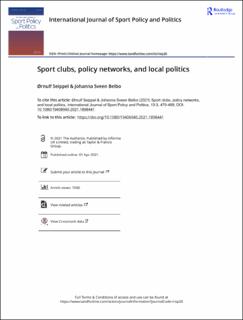| dc.contributor.author | Seippel, Ørnulf | |
| dc.contributor.author | Belbo, Johanna Sveen | |
| dc.date.accessioned | 2021-12-10T11:48:13Z | |
| dc.date.available | 2021-12-10T11:48:13Z | |
| dc.date.created | 2021-04-22T18:46:39Z | |
| dc.date.issued | 2021 | |
| dc.identifier.citation | International Journal of Sport Policy and Politics. 2021, 13(3), 479-499. | en_US |
| dc.identifier.issn | 1940-6940 | |
| dc.identifier.uri | https://hdl.handle.net/11250/2833765 | |
| dc.description | This is an Open Access article distributed under the terms of the Creative Commons Attribution-NonCommercial-NoDerivatives License (http://creativecommons.org/licenses/by-nc-nd/4.0/), which permits non-commercial re-use, distribution, and reproduction in any medium, provided the original work is properly cited, and is not altered, transformed, or built upon in any way. | en_US |
| dc.description.abstract | Sports clubs cooperate with other clubs, sports organisations, and public and market actors to organise sports. In this article, we study the way clubs cooperate through a sports club network involving only sports clubs and a wider sports policy network consisting of all relevant actors related to those clubs (e.g. the clubs, public and private actors, sports governing bodies, clubs outside the municipality). The context is a medium-sized Norwegian municipality. We answer three questions. First, what do these cooperative networks look like (e.g. density, centralisation and clustering)? Second, how do the networks develop (based on a theoretical framework comprising strategies, institutions and trust)? Third, what are the implications of the network characteristics we find for the dominant sports-for-all policy?
Methodologically, we depend on traditional network analyses and exponential random graph models (ERGMs), which include endogenous factors (density, reciprocity and transitivity), exogenous factors (actors’ attributes) and covariate networks (geographical distance between clubs). Based on theory, we suggest that the network structures we describe empirically make the clubs well suited for organising broad inclusive mass sports, but less so for inclusion of special targeted groups who are not as attracted to traditional club sports. | en_US |
| dc.language.iso | eng | en_US |
| dc.subject | centralisation | en_US |
| dc.subject | clustering | en_US |
| dc.subject | local politics | en_US |
| dc.subject | policy networks | en_US |
| dc.subject | social networks | en_US |
| dc.subject | sports clubs | en_US |
| dc.title | Sport clubs, policy networks, and local politics | en_US |
| dc.type | Peer reviewed | en_US |
| dc.type | Journal article | en_US |
| dc.description.version | publishedVersion | en_US |
| dc.rights.holder | © 2021 The Author(s) | en_US |
| dc.source.pagenumber | 479-499 | en_US |
| dc.source.volume | 13 | en_US |
| dc.source.journal | International Journal of Sport Policy and Politics | en_US |
| dc.source.issue | 3 | en_US |
| dc.identifier.doi | 10.1080/19406940.2021.1898441 | |
| dc.identifier.cristin | 1905919 | |
| dc.description.localcode | Institutt for idrett og samfunnsvitenskap / Department of Sport and Social Sciences | en_US |
| cristin.ispublished | true | |
| cristin.fulltext | original | |
| cristin.qualitycode | 1 | |
